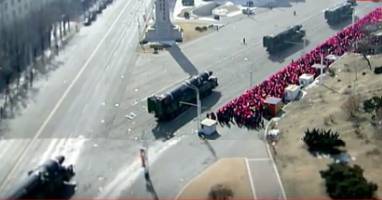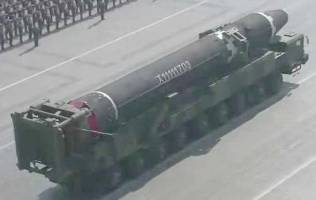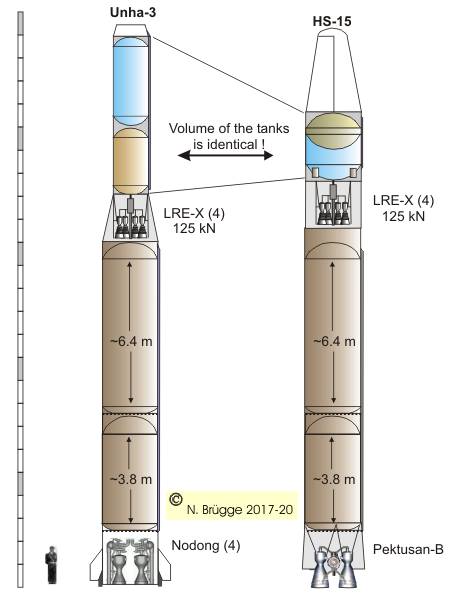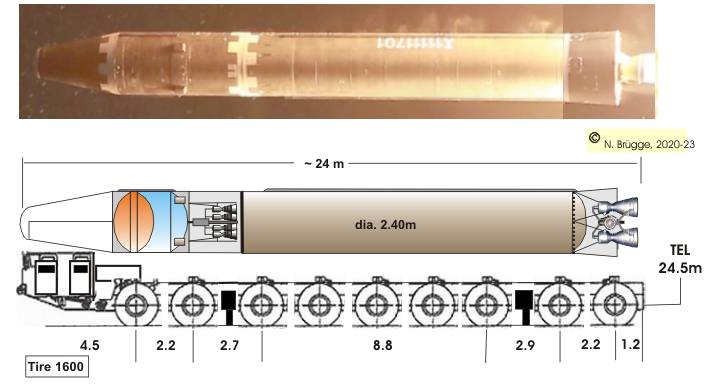|
North Korea's
questionable ICBM "Hwasong-15" (HS-15)
(How the Unha-3 was transformed to a
supposed ICBM)
Norbert
Brügge, Germany
We may have been wrong about the rating of the HS-15 as
ICBM. The launch of the HS-15 was probably the test of the second stage
of the new North Korean
Unha-X SLV, and the whole
staging of an ICBM is only for propaganda.
.
This monstrous vehicle HS-15 is a airframe of the Unha-3 launcher that
is not suitable for flat ballistic trajectories.The gimbaled
"Pektusan-B"
engine could support the assumption that this is a second stage for a
new big SLV.
On the other hand, the completed conversion of four from originally
six available 8-axle TEL's actually speaks also for the use as ICBM, at
least theoretically (right).
Note: The latest suppositions of some analysts
that the HS-15 is based on old Soviet ICBM technology is nonsense. The
called R-37/R-38 ICBM's were only project studies of a "light ICBM" of
OKB-586 (Yangel). |


2018,
Febr.
08 - North Korea presents four HS-15 during the parade
|
2017, November 29 (KCNA) -- The government of the Democratic People's
Republic of Korea announced a statement over the successful test-fire of
new-type Hwasong-15.
The HS-15 intercontinental ballistic missile tipped with super-large heavy
warhead. This system has much greater advantages in its tactical and technological
specifications and technical characteristics than HS-14.
The rocket soared to the highest altitude of 4,475 km and then flew the distance
of 950 km. After making a 53-minute flight along its present orbit, the rocket
accurately landed in the target waters set in the open sea in the East Sea
of Korea.
|

|


|
|

|

|

|

|
|

|
 |
 |

|
|

|

|

|

|
|
They seem to have found a way to
gimbal mount the two combustors of the engine. The platform to which
the turbopump and combustors are rigidly connected can no
longer be recognized. The turbopump is mounted higher.
|
|
|
The assumption that the HS-15 is a completely
new ICBM is doubtful. The HS-15 is a large two stage rocket. Unclear is,
if it is a projectile inside the shroud. I think it is a dummy.
So far, it is only certain that for the first time the complete engine
"Pektusan" (RD-250 clone) with two combustors and a common turbopump was
used. This increases the take-off thrust compared to the
HS-14 only to 170% (788 kN SL) because the steering engines are missing.
The function of the steering engines assumes the advertised thrust vector
control of the main engine. KCNA also reports that the thrust is even
controllable in some way ("speed correction in the mid-flight section").
The burning time of the engine must be longer as the observed 127...129
sec or the filling was reduced.
The propulsion of the second stage is completely unclear. It should not
come as a surprise, however, when to use
the engines from
Unha's second stage.
Dimensions of the missile
The scale for determining the dimensions of the missile was the length
of the new transporter with 24.5 m length. The result of mesurements is
a length the HS-15 of ~24.0 m. The diameter is 2.40 m
|
"It is my guess that
the HS-15 is a converted Unha-3. So far nobody has repeated this. But, I am
almost sure though. Diameter and length of the first stage are strikingly
in agreement. Only the engines were replaced ("Pektusan").
The second stage is probably a down-scaled Unha-3 second stage.
The HS-15 was launched at a steep angle. After burning out (5 min or longer,
when the second stage ignited after a coast-phase), the warhead had a long
free-flight phase up to speed 0 up to a height of 4475 km, and then dropped
back. I can not say anything about the range of the warhead when the missile
launching along a low ballistic trajectory. I have to leave that to the specialists.
It is spoken by 13000 km.
About the final speed of the rocket after end burn time can only be speculated,
because we not accurate know the weight/thrust ratios. However, I assume that
the necessary speed will be missed significantly in order to send a warhead
into the earth orbit (FOB)." (My Interview with Difesa Online, Roma, Dec.
04)
|

|

|
Stage
|
Engines
|
Thrust s.l.
|
Isp s.l.
|
Thrust vac
|
Isp vac
|
Propellant
|
Burn time
|
Flow rate
|
Total Imp
|
|
kN
|
N*s/kg
|
kN
|
N*s/kg
|
-
|
t |
s
|
t/s
|
MN*s (vac)
|
|
1 |
Pektusan-B (1x2)
|
787.8
|
2638
|
880.0
|
2947
|
UDMH/N204
|
56.74
|
190
|
0.2986
|
167.2
|
|
2 |
LRE-X
(4)
|
|
|
125.0 |
2501 |
UDMH/N2O4 |
11.0 |
220 |
0.0500 |
27.5 |
The take-off weight of the HS-15 is estimated at approximately 75 to 76
t.
|
|
|
|




















